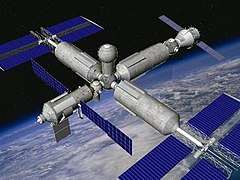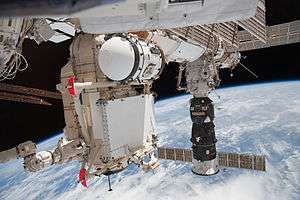Orbital Piloted Assembly and Experiment Complex
The Orbital Piloted Assembly and Experiment Complex (Russian: Орбитальный Пилотируемый Сборочно-Экспериментальный Комплекс, Orbital'nyj Pilotirujemyj Sborochno-Eksperimental'nyj Kompleks)[1][2] (ОПСЭК, OPSEK) was a 2009–2017 Russian proposed third-generation modular space station for Low Earth orbit.
 Computer-generated depiction of OPSEK | |
| Station statistics | |
|---|---|
| Crew | 2 or more |
| Launch | 2020s |
| Launch pad | Baikonur Cosmodrome |
| Mass | over 100,000 kg when complete |
| Atmospheric pressure | 1 atm |
| Periapsis altitude | 370 to 450 km (planned) |
| Apoapsis altitude | 370 to 450 km (planned) |
| Orbital inclination | 70 degrees (planned) |
| Typical orbit altitude | 370 to 450 km (planned) |
| Orbital speed | approx 28,000 km/h |
| Orbital period | approx 90 minutes |
| Orbits per day | approx 15 |
| Days in orbit | 0 |
| Days occupied | 0 |
| No. of orbits | 0 |
The concept was to use OPSEK to assemble components of crewed interplanetary spacecraft destined for Mars, the Moon, and possibly Saturn. The returning crew could also recover on the station before landing on Earth. Thus, in the concept, OPSEK could form part of a future network of stations supporting crewed exploration of the Solar System.
In early plans, the station was to consist initially of several modules from the Russian Orbital Segment of the International Space Station (ISS). However, in September 2017, the head of Roscosmos Igor Komarov said that the technical feasibility of separating the station to form OPSEK had been studied and there were now "no plans to separate the Russian segment from the ISS ... We keep the same position, that we should work on the ISS together with our partners."[3]
Overview
Around the predicted decommissioning of the International Space Station in the late 2020s, the Russian Federal Space Agency (Roscosmos) developed a concept in 2009 to construct a successor station in low earth orbit.[1][2]
The 2009 concept considered re-using several ISS modules to form the initial parts of a new station, which were to be subsequently replaced by new modules.[4] On 17 June 2009, Roscosmos officially informed its ISS partner NASA about its intention to "build and prepare for operation the first elements of the orbital assembly and experimental piloted space complex by the end of the ISS life cycle.".[4] As of 2017, those plans had been abandoned, and the new station was to be composed entirely of new purpose-built modules.[3]
According to the Russian crewed spaceflight contractor RKK Energia, the new station must be able to perform the following tasks:[5]
- Large spacecraft assembly
- Flight tests and launches
- Creating, servicing and completing inter-orbital tugs
- Providing medical and biological conditions required for the rehabilitation of interplanetary expedition crews after their return to Earth orbit.
Structure
OPSEK was to have followed the Salyut and Almaz series, Kosmos 557, and Mir as the 12th Russian space station launched. OPSEK is a third generation[6] modular space station.[7]
Examples of other modular stations include the former Soviet/Russian Mir, the International Space Station, and the proposed Chinese space station. The first space station, Salyut 1, and other one-piece or "monolithic" first generation space stations, such as Salyut 2, 3, 4, 5, DOS-2, Kosmos 557, Almaz, and NASA's Skylab station, were not designed for re-supply.[8] Generally, each crew had to depart the station to free the only docking port for the next crew to arrive. Skylab had more than one docking port but was not designed for resupply. Salyut 6 and 7 had more than one docking port and were designed to be resupplied routinely during crewed operation.[9] Modular stations can allow the mission to be changed over time and new modules can be added or removed from the existing structure, allowing greater flexibility.

Modules
Expected Russian Orbital Segment modules around the time of OPSEK separation (2020 or later) arranged by launch dates:
Poisk (Russian: По́иск; lit. Search), also known as the Mini-Research Module 2 (MRM 2), Малый исследовательский модуль 2, or МИМ 2. Poisk is a Russian airlock module with two identical hatches. Its predecessor, Pirs, is used to store, service, and refurbish Russian Orlan suits. The outermost docking ports on both airlocks allow docking of Soyuz and Progress spacecraft, and the automatic transfer of propellants to and from storage on the station.[11]

- 2020, Nauka (FGB-2) - to form part of OPSEK
Nauka (Russian: Нау́ка; lit. Science), also known as the Multipurpose Laboratory Module (MLM) or FGB-2, (Russian: Многофункциональный лабораторный модуль, or МЛМ), is the major Russian laboratory module. This module will be separated from the ISS before de-orbit with support modules to become the OPSEK space station. It contains an additional set of life support systems and orientation control. Nauka's mission has changed over time; during the mid-1990s it was intended as a backup for the first FGB, and later as a universal docking module (UDM). Its docking ports will be able to support automatic docking of both spacecraft, additional modules and fuel transfer. Prior to the arrival of the MLM, a Progress robotic spacecraft will dock with the ISS PIRS module, depart with that module, and both will be discarded. Nauka will then use its own engines to attach itself to the ROS after 2014.[12] The European Robotic Arm, which will service the Russian Orbital Segment, will be launched alongside the MLM.[13]
.jpg)
- 2020, Uzlovoy Module - to form part of OPSEK
Node Module (UM)/(NM) This 4-ton ball shaped module will support the docking of two scientific and power modules during the final stage of the station assembly and provide the Russian segment additional docking ports to receive Soyuz TMA (transportation modified anthropometric) and Progress M spacecraft. NM is to be incorporated into the ISS in 2016. It will be integrated with a special version of the Progress cargo ship and launched by a standard Soyuz rocket. The Progress would use its own propulsion and flight control system to deliver and dock the Node Module to the nadir (Earth-facing) docking port of the Nauka MLM/FGB-2 module. One port is equipped with an active hybrid docking port, which enables docking with the MLM module. The remaining five ports are passive hybrids, enabling docking of Soyuz and Progress vehicles, as well as heavier modules and future spacecraft with modified docking systems. More importantly, the node module was conceived to serve as the only permanent element of OPSEK. Equipped with six docking ports, the Node Module would serve as a single permanent core of the future station with all other modules coming and going as their life span and mission required.[14][15] Uzlovoy will be launched after Nauka MLM; launch dates will be 2017 or later [16]
- 2022, Science and Power Module 1 (NEM-1) - to form part of OPSEK.[17]
ROS Modules not utilized in OPSEK
Russian Orbital Segment modules scheduled for de-orbiting:
- 2014, Pirs (DC-1) - to be de-orbited before the launch of MLM Nauka and that module will utilize the current Pirs port at the ISS.
Russian Orbital Segment modules that were neither scheduled for de-orbit nor included in the OPSEK proposals:
References
- "Orbital Piloted Assembly and Experiment Complex, OPSEK". RussianSpaceWeb.com. Retrieved 26 October 2017.
- "Russia 'to save its ISS modules'". BBC News. 2009-05-22. Retrieved 28 December 2018.
- Foust, Jeff (25 September 2017). "International partners in no rush regarding future of ISS". SpaceNews. Retrieved 28 December 2018.
Komarov: We have no plans to separate the Russian segment from the ISS ... We keep the same position, that we should work on the ISS together with our partners.
- Zak, Anataloy (2009-07-03). "Orbital Piloted Assembly and Experiment Complex". Russianspaceweb.com. Retrieved 2009-07-04.
- "Russia could build orbital assembly complex after 2020 - Energiacorporation". Interfax. 2009-08-18. Archived from the original on August 18, 2009. Retrieved 2009-08-18.
- Redaktion dlr.de; as/eh/sh. "DLR - International Space Station ISS - From Cold War to international cooperation - the story of the ISS".
- "Third Generation Soviet Space Systems". Archived from the original on 2012-06-18.
- spaceflight.nasa.gov/spacenews/factsheets/pdfs/history.pdf
- "Space Station - The Station - Russian Space History".
- Orbital Piloted Assembly and Experiment Complex
- "Pirs Docking Compartment". NASA. 10 May 2006. Retrieved 28 March 2009.
- "Роскосмос сообщил НАСА, что модуль МЛМ не войдет в состав МКС в 2014 г". РИА Новости.
- "ERA: European Robotic Arm". ESA. 16 January 2009. Retrieved 4 October 2009.
- S.P. Korolev RSC Energia – News. Energia.ru (2011-01-13). Retrieved on 8 October 2011.
- Node Module. Russianspaceweb.com. Retrieved on 8 October 2011.
- "UM (Prichal, NM, Progress-M-UM)". skyrocket. Retrieved 21 July 2016.
- Zak, Anatoly. "Russia works on a new-generation station module". www.russianspaceweb.com. Anatoly Zak. Retrieved 5 April 2016.
- "Zarya". NASA.
- "NASA - ISS Assembly Mission ULF4".
External links
- OPSEK information page
- Presentation, by Head of Russian Federal Space Agency, June 17, 2009

- RSC Energia: Science Research on ISS Russian Segment




